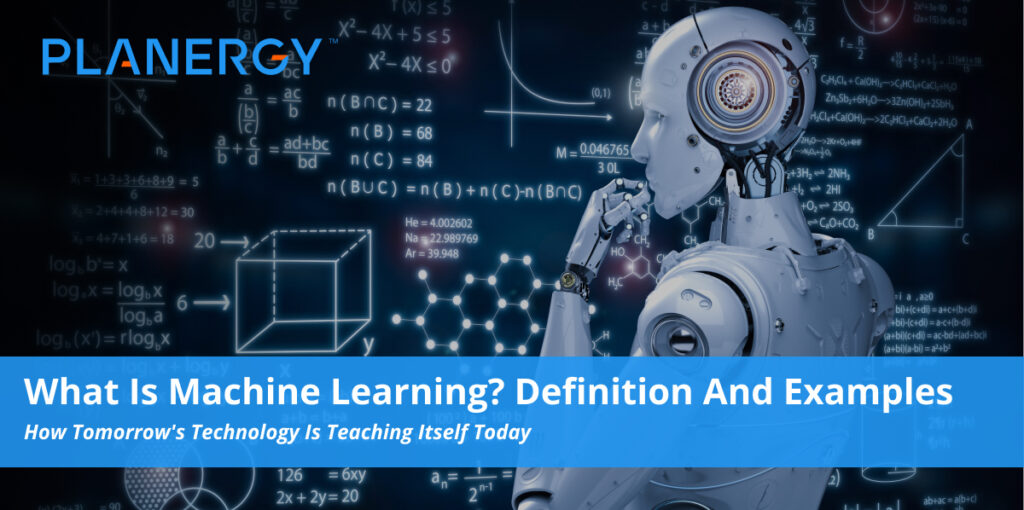To gain and maintain competitive performance in today’s global marketplace, your business needs to take advantage of the tools that make it possible to be more productive, proactive, and efficient while reducing waste and expense.
For many businesses big and small, that means tapping into next-gen technologies like machine learning. What is machine learning? In a nutshell, it’s the secret to teaching technology to optimize all of your business processes.
But before you can harness the power of machine learning and its capabilities, you need to understand what it is, how it works, and the ways it’s already transforming the way the world does business.
Take a closer look and see how this exciting technology can help your business compete and succeed.
How Machine Learning Works
While it’s often used as a synonym for artificial intelligence (AI), machine learning is distinct from it, as it is a specific application of artificial intelligence technology.
The purpose of machine learning is to teach systems to improve their own performance over time, experientially—in effect, machine learning helps programs access information and use it to teach themselves.
When computers can learn automatically, without the need for human help or correction, it’s possible to automate and optimize a very wide range of tasks, recalibrated for speeds and volumes not possible for humans to achieve on their own.
Machine learning takes place in many of the same ways as its organic counterpart.
By reviewing data provided by humans via instruction, examples and hypotheticals, and their own observations and experience (including “seeing” with computer vision), computer programs built to use machine learning algorithms search for patterns and correlations they can use to improve their responses, decisions, and planning.
Another term—deep learning—is also often used to describe the machine learning process, but just as machine learning is a subset of artificial intelligence, deep learning is a subset of machine learning.
This may seem like splitting hairs, but it’s crucial to discussing the capabilities of and applications for each with regard to data science technology—especially as you dive more deeply into the specific areas each machine learning method addresses.
Machine learning algorithms are organized into a variety of categories, generally split between two “master” categories: supervised machine learning algorithms and unsupervised machine learning algorithms.
Two other categories, semi-supervised machine learning and reinforcement machine learning, are used to describe special types of algorithms designed for specific circumstances.
Supervised Machine Learning Algorithms
These algorithms are trained using organized input data sets made up of labeled examples. Using these data sets—often called training datasets—computer programs are taught to recognize input, output, and the steps required to turn the former into the latter.
Over time, the algorithms learn to predict outputs based on patterns learned from the training data.
More importantly, they can compare their own output to the correct or desired output to pinpoint errors in their processes and make changes to their workflows to improve performance.
Supervised machine learning algorithms are useful for training artificial neural networks, as multiple algorithms can collaborate on shared tasks and optimize both their own work and the process as a whole over countless training iterations.
Unsupervised Machine Learning Algorithms
When the data used to train an algorithm is both unlabeled and unclassified, unsupervised machine learning algorithms are used.
Rather than relentlessly refining their ability to achieve optimal output as compared to a desired outcome, unsupervised learning algorithms are designed to identify and excavate the structures and patterns hidden within data sets based on exploration of the data and inferences it’s drawn over time.
Consequently, unsupervised learning is a complement, rather than an alternative, to supervised machine learning; if the latter is about how well a program can teach itself to perform a task, the former is about how well the program can learn what it’s supposed to be learning in the first place.
Semi-Supervised Machine Learning Algorithms
A mix of both supervised and unsupervised machine learning algorithms, this approach blends a dash of labeled data with a much larger dose of unlabeled data to train the algorithm.
The labeled data acts as a germination point for data analysis and pattern recognition, pushing the program to improve accuracy over time.
Natural Language Processing (NPL) is one of the most widespread applications of semi-supervised learning algorithms.
Teaching machines how to understand queries and responses phrased in a natural way, rather than a specific search format or lingo, requires a learning process that can emulate the human brain.
Semi-supervised learning provides that flexibility while still allowing for guidance as required.
Reinforcement Machine Learning Algorithms
Like human children learning as they grow, reinforcement machine learning algorithms use trial and error to gain knowledge and prioritize behaviors as they work toward a specific reward or incentive.
This method is more reactive than prescriptive, and uses feedback to teach the programs which actions and reactions are best as they go along.
Reinforcement learning is an important part of process automation, where improvisation is much less important than affirming the best possible outcomes for continuous improvement.
Implementing a centralized, AI-powered, and cloud-based procurement software solution like Planergy gives companies access to the tools they need to make machine learning a core component of both procurement optimization and value-driven business process management for their entire organizations.
Real-World Applications of Machine Learning
As you might expect in a world with a growing dependence on Big Data, machine learning models are essential to transforming that data into useful insights, more strategic sourcing and planning, and greater innovation.
For example, in the procurement industry, machine learning is used for a wide array of purposes, including smarter automation of common workflows, streamlining and optimizing the entire procure-to-pay process, and simplifying everything from contract and compliance management to supply chain optimization and supplier relationship development.
Implementing a centralized, AI-powered, and cloud-based procurement software solution like Planergy gives companies access to the tools they need to make machine learning a core component of both procurement optimization and value-driven business process management for their entire organizations.
Machine learning also helps improve ancillary tasks that create value and savings, such as improved fraud detection (from eliminating rogue spend and using automated three-way matching to reduce invoice fraud).
But it’s not just procurement where machine learning shines. Companies around the world are putting machine learning systems to use in a range of applications.
Aside from its role as search engine to the world, the megacorporation from Mountain View has also invested considerable time and effort into artificial intelligence, machine learning, and deep learning to create products such as its automated chatbots.
While chatbots have a somewhat rocky history with the public at large thanks to unfortunate incidents involving racist Twitter chatbots and other PR nightmares, they continue to attract attention and investment as they become ever-more sophisticated thanks to evolving programming techniques and algorithms.
Google also uses machine learning to improve search engine performance, power Google Translate with help from advanced NLP and cutting-edge artificial neural networks.
Incidentally, Google isn’t just using machine learning; it’s providing tools for developers to create their own machine learning applications. Developers no longer need to be data scientists to create data mining applications or integrate speech recognition into the search function of their apps.
IBM
The granddad of the modern computing industry, International Business Machines (IBM) has been in the artificial intelligence and machine learning game for quite a while.
In addition to developing Deep Blue—a computer that famously learned from its time playing world-famous chess star Garry Kasparov and went on to beat him again and again in subsequent games—IBM has also created Watson, the computer which competed on television game show Jeopardy! and handily beat all human challengers.
Machine learning comes into play via IBM’s own line of AI products, powered by the same AI tools that created Watson. Using these tools, developers can create their own applications powered by machine learning techniques to perform specific tasks from identifying and eliminating malware to refining supplier management to providing customer support via a chatbot of their own.
Microsoft
Microsoft refers to its proprietary machine learning platform as Azure, and like Google and Amazon, offers developers a chance to utilize machine learning tools in (for example) Python-based applications without the need for advanced programming tools or data science knowledge.
As a retailer, Microsoft also uses machine learning to perform data mining, data analysis, and forecasting.
In addition, Microsoft’s own artificial intelligence agent, Cortana, relies on machine learning to respond to queries and perform tasks.
Netflix
The media company that helped redefine the way we consume media by making “binge-worthy” content the new standard is, in its own words, in the business of “learning how to entertain the world.” Netflix uses machine learning extensively within its platforms and applications, using both unstructured and structured machine learning algorithms to:
- Respond to spoken and written searches using speech recognition and NLP.
- Recommend content.
- Optimize bitrate, video, and audio based on available bandwidth and other resources.
- Analyze data to create highly targeted marketing campaigns.
- Develop new content based on data mining analysis of data sets including performance of existing content and characteristics shared by successful productions.
Amazon
This global online juggernaut is something of a double threat with regard to machine learning capabilities, as it is both a heavy user of machine learning in its own operations, like Netflix, and a producer of machine learning tools it sells to others in the same way Google, IBM, and Microsoft do.
Like Netflix, Amazon uses machine learning to analyze content-related statistics in order to recommend content, create new content, and grow its own subscriber lists.
However, because it is also a massive global retailer, machine learning is also used to:
- Respond to search queries, using speech recognition and NLP.
- Analyze customer behavior in order to:
- Recommend new products.
- Suggest reorders.
- Create new products to meet projected demand.
- Perform fraud detection.
- Generate advanced forecasts drawing from multiple algorithms to optimize their supply chain.
Social Media Titans
The implicit agreement we all make with social media is the free availability of some or all of our personal information and visibility into our online behavior in exchange for communication tools, online socialization, and entertainment.
Companies like Twitter, Facebook, and LinkedIn mine our behavioral patterns, posts, and reading/watching/listening/sharing trends to market products, add new features (or remove unpopular ones), and attract advertisers eager to put our data to use for their own purposes.
But social media companies aren’t the only ones using the endless stream of posts for their benefit.
Enterprising individuals and companies capture data sets from Twitter and feed them to machine learning algorithms to handle a staggeringly varied range of tasks, from identifying “mean” tweets through natural language processing to identifying critical security risks for both fun and profit.
In addition, companies interested in protecting their reputations while collecting valuable insights into customer perceptions and buying patterns are increasingly using deep learning to collect and analyze mentions of their goods, services, and general company profile across social media.
Applying machine learning to social media data sets can help companies adjust their customer service policies, react to emergencies, reduce risk of compromising their reputation due to hot button issues, and improve forecasting and decision making.
Machine Learning Helps Your Team Work Smarter, Not Harder
From social media to shopping online, machine learning now plays an important part in our online lives.
Understanding its capabilities can help you put them to good use, whether you’re building your own app or mining data to enhance customer experience and grow your market share.
And while your company may not be ready to challenge Google or Amazon for chatbot superiority or take on Watson in the local pub trivia challenge, you can still tap into the power of machine learning to help your business build value, optimize workflows, and improve its overall competitive performance.
Invest in a comprehensive procurement solution with built-in support for AI and machine learning, and you’ll be ready to automate your P2P process, improve collaboration and communication, and improve all your business processes across your company.




